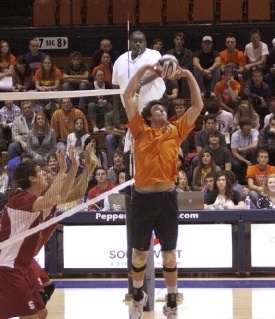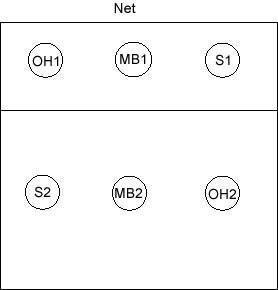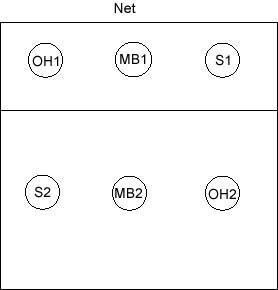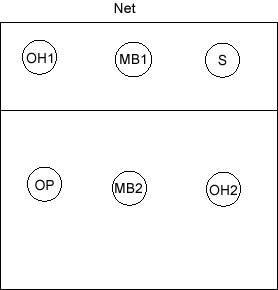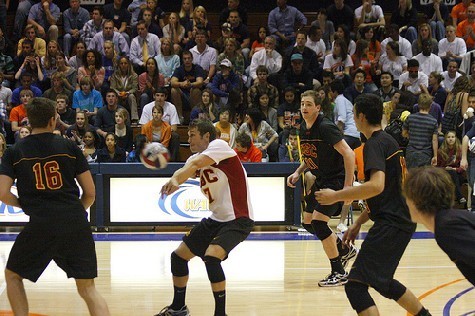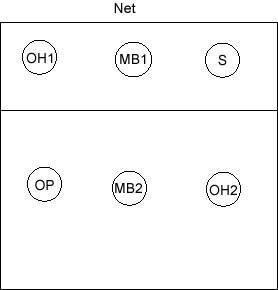Selecting a volleyball offense is one of the most important decisions to make when you are just starting. Next, I will show you how each of these offenses run and how you can use each of them. I also will tell about my experiences with each and why I prefer one over another.
Keep in mind that different coaches have different styles and so they will select a volleyball offense they are familiar with. Or, they could select an offense that is better suited to the players they have to work with. There really isn’t one right answer on this. It also depends on the level of the coach and team. Some coaches have teams that are after volleyball scholarships, and others are focusing on teaching the fundamentals and having fun.
As I outline these offenses for you, keep in mind that each volleyball offense has two numbers associated with it. The first number represents the number of hitters or attackers. The second number is the number of setters used in the offense.
The first volleyball offense to cover is the 4 2 offense. This means that there are 4 hitters and 2 setters on the floor. The two setters will play opposite each other and they will set when they are on the front row leaving two hitters at all times on the front row.
This type of offense has it’s limitations. First of all, since the setter is always setting when they are on the front row, there are only two attackers. This limits the amount of plays that can be run and it becomes real easy to identify where the set is going to go.
Personally, I have never liked this type of an offense. It seems too limiting. Sure the setter can dump the ball and in a sense can be an attacker, but the blockers on the other team can cheat over since there are only two real attackers. Double and triple blocks are going to be very common on this type of an offense. To learn more about the 4 2 offense, click here.
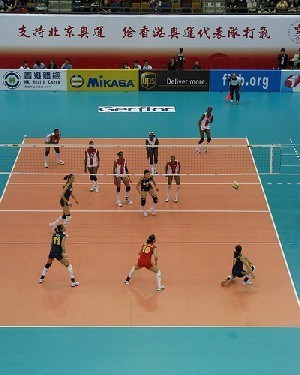
The next type of offense is the 6 2 offense. This means that there are 6 hitters and 2 setters.
The main difference between the 6 2 offense and the 4 2 offense is that the setter is going to come off the back row and set the ball. Since the setter is coming off the back row, there will always be three hitters on the front row.
The setters will again play opposite each other in the rotation. When a setter gets to the front row, they will also become a hitter with the back row setter taking over setting responsibilities.
I am also not a huge fan of this offense either. I have been on teams that played this, and I didn’t think the team functioned as well as it could have. Let me explain why…
On the web page that explains the positions, I mentioned that the setter is just like the quarterback as they are running the offense. Can you imagine two quarterbacks trying to run one offense? It seems odd and it has the same effect in volleyball.
Since I play middle blocker, I did not like this volleyball offense. It seemed odd to adjust to two different setters constantly as they both set the ball differently and have different tendencies. Learn more about the 6 2 offense here. The last volleyball offense to cover is the 5 1 offense. Now we are talkin’!
As you can tell, this is my preferred offense. There is one setter that has the setting responsibilities all the way around and five hitters.
I like this offense because it is easier for one person to run the offense and it is easier for the hitters to get used to one setter instead of adjusting to two different setters.
Regardless of which offense you use, you will need to know how to receive the serve. These various volleyball formations will help you structure it correctly.
Free Stuff!
Don’t forget to get your free volleyball tools. Check it out for more details!
If you are planning on playing this offense, the first thing you need to do is understand the 6 positions of volleyball and their starting rotation. You can click here for the 6 positions explanation to get your offense started.
If you want a more detailed explanation of the offense works, use this link: Read more about the 5 1 offense by clicking here.
Besides the various offenses that can be played, there are a number of plays that can be called. In order for these plays to work, the setter and hitters must be prepared for them and know the signals.
Although, all teams have their own signaling system, here is the system that our team uses. I probably shouldn’t share this, but I want to teach people how to be successful at this sport. Learn our secret play calling system here.The last part of volleyball offense that is important to know about is the volleyball rotations. After every side out, the offensive team rotate one position clockwise. This is a simple concept but as people rotate, it is important to know where to line up so that people can play their designated positions.
Speaking of hitting the ball, do you know how to spike a volleyball? That is important to learn.
There is nothing worse than lining up incorrectly and having the middle blocker passing the ball on a jump serve. Can you say shank city?
As players are rotating, adjustments are made as to where people are standing so that the offense can still run effectively. Volleyball rotations are explained here.
Want to know how to gauge your offensive performance? Click here to learn about the Passing Points System to determine how well the offense is doing. After reading this information, you will know how to use this system to know about game performance, but also this can be used to know what to practice on during your practices.
You might also want to check out the information about volleyball scoring.

